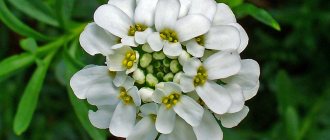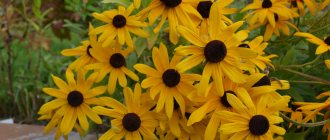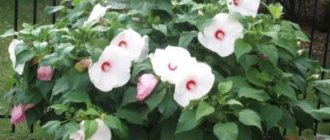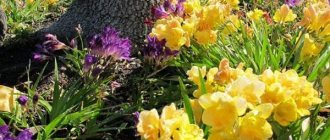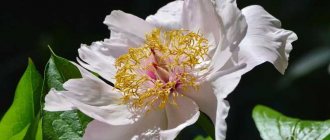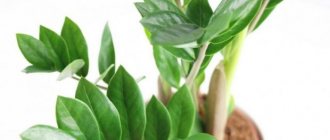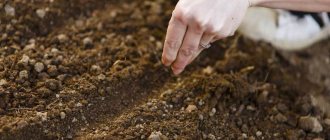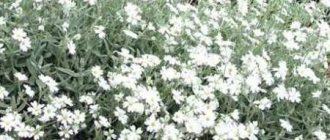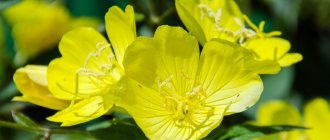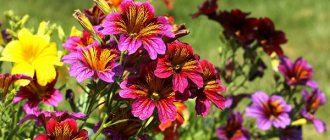Botanical description of a houseplant
Syrian hibiscus is a member of the mallow family. Its Latin name is Hibiscus syriacus. Known as Syrian rose or ketmia. This tropical plant came to Russia from China. In nature it reaches a size of 5-6 m. It is cultivated in open ground in the south of Russia and Ukraine, as well as in :
- Crimea.
- Central Asia.
- Moldova.
The bush grows to a height of 1.5-2 meters. Its flowers are large, 20-25 cm in diameter. Their petals, depending on the variety, are :
- red;
- purple;
- white;
- pink;
- dark crimson.
The plant blooms from July to October. Many flower buds are formed on it.
Reference! Over the course of 2 days, the flower manages to bloom, wither and crumble.
Growing in open ground
In Russia, among other wild plants, the following types of hibiscus are common:
- Syrian (rosella, hibiscus);
- northern;
- swampy
All of the above varieties are suitable for garden design. Among modern gardeners, hybrid varieties and Syrian hibiscus, famous for its unpretentiousness and adaptability, are in demand. They are the ones who build up a powerful root system that allows the plant to survive in severe frosts.
For hibiscus, planting and care are reduced to a minimum list of procedures, including:
- choice of location;
- preparing the landing pit;
- transplant;
- watering;
- pruning;
- fertilizing
The ideal place for seedlings will be a flat, well-lit area, protected from the wind. When choosing a corner for placement, it is worth considering that plants planted in close proximity to iron structures can burn at particularly high temperatures. In this regard, you should avoid planting hibiscus near metal fences and fences. Heavily shaded areas and stagnant water can cause chlorosis and also attract mites and aphids.
The planting hole should exceed the volume of the root ball by 2 times. The root system of most Chinese roses (except for swamp hybrids) does not tolerate waterlogging of the soil. In this regard, when preparing a planting hole, a drainage layer is lined at the bottom of the hole. Fill in red brick crumbs (no more than 12-15 cm), and river sand (no more than 10 cm) on top of it. Compost (about 15 cm) is used as a fertile layer. To prepare, take a mixture of garden soil, peat and river sand in a ratio of 2:4:1.
The root ball is placed exactly in the center and dug up to the tillering node. The seedling is watered abundantly. To protect against pests, the tree trunk circle is sprinkled with a mixture of crushed coal and wood ash. The soil in the hole is mulched with fine sawdust or ash.
Growing in a flowerpot
Planting and care in open ground are not much different from the technology for growing indoor varieties. A drainage layer of cork, pieces of polystyrene foam, small pebbles or broken bricks is also placed at the bottom of the pot, and a fertile layer is poured on top. The size of the container should exceed the volume of the root ball by 2 times. Otherwise, the process of bud formation will slow down or stop until the root system fills the pot.
In the spring and summer, small containers with tree-like hibiscus are moved into the garden. Large flowerpots are placed closer to the windows or sent to the balcony. Indoor plants are protected from drafts and scorching sun.
Popular species and their photos
They like to decorate gardens with Syrian hibiscus, because it stands out for its variety of shades and colors. In the photo you can see what the varieties of Syrian hibiscus look like.
Oiseau bleu
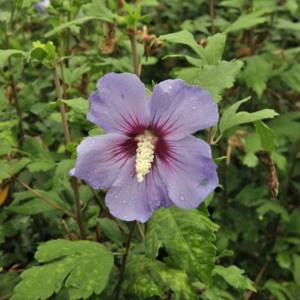
Hibiscus Oziau Blue is a deciduous shrub that grows to a height of 2-3 m. Its dark green leaves, up to 10 cm long, have denticles at the edges. Single blue flowers have a red center. The plant needs to be covered for the winter.
Red Heart
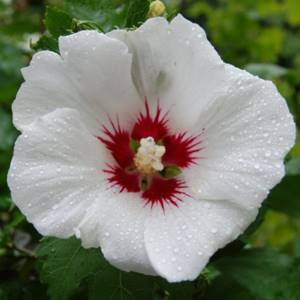
Red Heart Hibiscus is a shrub:
- straight;
- fast growing;
- compact.
It has a uniform, dense crown and large white flowers. Their central part is painted red. The strong branches of an adult plant reach 1-2 m in width and 1.5-2.5 m in height. The dark green leaves are egg-shaped, similar to chrysanthemum leaves. They bloom late. If the spring is cold, the leaves turn yellow-white.
Matilda
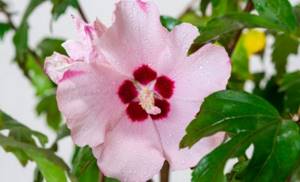
Hibiscus Matilda is considered one of the most beautifully flowering varieties. Reaches a height of 2-3 m. Dark green leaves with a jagged edge grow up to 10 cm. The flowers are pink with a red spot.
Mike
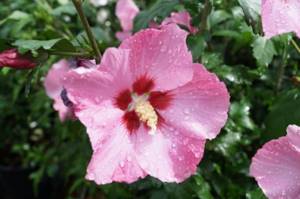
Blue Chiffon
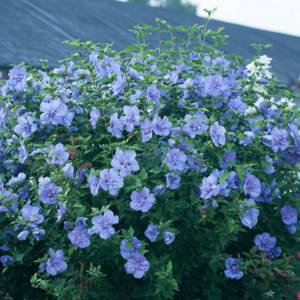
Hibiscus Blue Chiffon (not to be confused with the Chiffon variety) stands out for its excellent color. Dense blue buds appear among the small green leaves. This flower variety is resistant to drought and frost. It requires plenty of sunlight, so it is recommended to plant it in the garden.
Duc de Brabant
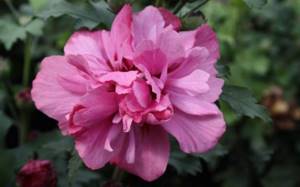
Ardens
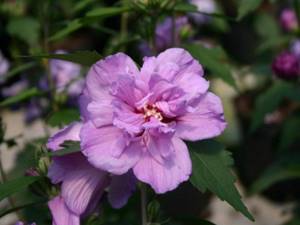
The Ardens cultivar is compact. This shrub has a uniform and dense crown and double purple flowers. The vertical branches are quite strong. An adult plant extends 1-2 m in width and reaches 1.5-2.5 m in height. Green ovoid leaves are similar to chrysanthemum leaves and bloom late. Ardens blooms with double large flowers of red-violet or purple color, in the center there is a 9.5 cm spot the color of red wine.
Flower care
Syrian hibiscus is considered an unpretentious plant . It is not difficult to care for him.
- When new green shoots appear, it is necessary to cut off the dried and old ones.
This flower does not react well to nearby weeds, so they are regularly destroyed. It is necessary to prevent the bush from becoming too dense. Important! In order for the flowering to be abundant and lush, the Syrian hibiscus must grow in a well-lit place. - As a single plant, this flower is not as attractive as when combined with other species. Several hibiscus bushes planted together with flowers of different colors also look great. They must be hidden from the wind, as they are badly affected by drafts. It must be borne in mind that non-double varieties are more resistant to frost.
- For Syrian hibiscus, the most suitable soil is considered to be one intended for growing roses, namely permeable and fertile. And in order for it to grow well, it needs to be systematically loosened.
- After one flower withers, another appears - this is a pattern. Their massive drying out should alert you, since most likely the plant needs more frequent watering. The soil around the flower should not dry out. This flower should be watered moderately and after the top layer has dried. It requires regular watering during the hot months.
- The plant responds well to fertilizers containing a large amount of phosphorus. Fertilizing is carried out during abundant flowering, namely from the beginning of summer until autumn, once every 2 weeks. It is very useful to use mineral and organic fertilizers in turn. At the beginning of autumn, you need to add potassium fertilizer to the soil, this will help the flower to withstand the cold season well. Fertilizing is not carried out in autumn and winter.
- The plant needs to be pruned, this promotes the formation of a compact crown and abundant flowering. Spring pruning of a flower growing in open ground is a necessary sanitary measure, since shoots damaged by frost are removed.
Read about all the features of growing such hibiscus here.
Planting in spring
Hibiscus are ornamental trees and shrubs well suited for decorating plots of land. They have large, beautiful flowers and are not particularly whimsical.
The following varieties are best suited for planting in open ground:
- Magenta Chiffon;
- Oziau Blue;
- Matilda;
- Red Hart;
- Woodbridge;
- Mike;
- Monstrosus;
- Du de Brabant.
All varieties require the same care, but have different appearance. Each variety is unique in its own way.
Choosing a location and lighting
Planting hibiscus (Syrian rose) should be done in an area not exposed to strong gusts of wind, but with good lighting. In landscape design, the best place to plant a plant is close to a fence or wall, but this place should not be fenced on all sides.
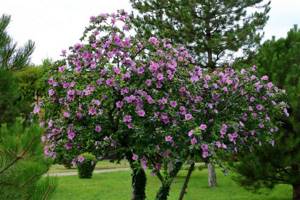
Planting is carried out only when the soil is well warmed up and the air temperature is consistently high. Young Syrian rose does not tolerate temperature changes and frosts.
Before planting hibiscus in open ground, the soil must be prepared; to do this, you need to dig a planting hole twice the size of the root system, and lay a layer of expanded clay on the bottom. The prepared area needs to warm up for at least a day, after which you can begin planting.
The plant should be installed in the prepared place, and then sprinkled with prepared soil, so that the root collar is covered only 5 cm with soil.
The soil
The soil for planting should consist of leaf soil, sand, turf and humus. In ordinary garden soil, the plant may not be accepted and die.
For better growth and development of the young plant, charcoal is added to the substrate; in this case, planting in open ground will be easier and the tree-like hibiscus will acclimatize faster.
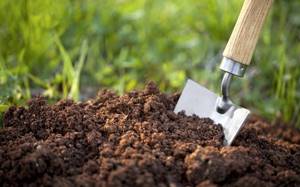
Watering
Home care involves regular watering. In spring, the soil should be moistened abundantly every day. In the cold season, watering should be reduced by 2-3 times.
The plant loves moisture on the leaves, so during hot periods it should be sprayed daily to wash away dust from the leaves and moisturize the crown.
After watering, the top layer of soil should be loosened to prevent the formation of a dense lump that will interfere with the normal growth and development of the plant.
Reproduction
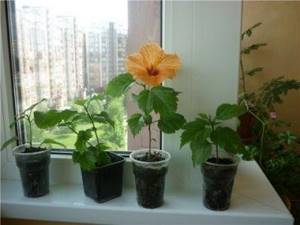
You can propagate the plant:
- seeds;
- layering;
- dividing the bush.
The simplest is considered to be cuttings from young cuttings that have 2-3 nodes. They are cut with a sharp knife and placed in water until roots appear. In order for this to happen quickly, it is recommended to treat the cut with special growth stimulants. When roots appear on the cuttings, it is planted in a pot with soil prepared in advance.
For the winter, the young plant is left indoors, and with the arrival of spring it is planted in open ground . If you want to immediately plant it outside, then it must be insulated for the winter.
We invite you to watch a video about propagating hibiscus by cuttings:
We invite you to watch a video about planting hibiscus seeds:
Transplantation and propagation
In principle, hibiscus does not need to be replanted throughout its entire life, but if the need for this does arise, then it, like planting, should be carried out in early spring after annual pruning of the shoots to half their length and before flowering begins. The transplantation scheme is the same as during planting. Caring for a transplanted flower is no different from the care described above, except that after transplantation you should definitely water it.
Propagation of the Syrian rose is carried out in the following ways:
- seeds.
- cuttings.
- layering.
- vaccination.
The first two methods are the most popular, the third and fourth are used less frequently.
The seed method can be practiced already in winter: the seeds should be soaked for half an hour in a dark pink manganese solution, and then for a day in the Hellene solution so that it barely covers them, then sown in containers with a sand-peat mixture, covered with glass and placed in a place with a temperature of +25-27, if necessary, organizing heating from below. Before planting in open ground, you need to ventilate the container, remove condensation and moisten the soil. When the seedlings have their first leaves, they can be planted in flowerpots. Particular attention should be paid to ensure that the seedlings do not stretch due to lack of light. If you notice this, be sure to use artificial lighting. Young plants are planted in open ground only in mid-May.
Some gardeners prefer to sow seeds directly into open ground. This should be done only in May or June to ensure that frosts are avoided and that the soil warms up well. You need to sow the seeds in loosened soil, making shallow grooves, then, having moistened the soil in advance, you need to cover the crops with film - this will speed up germination. If everything is done correctly, in two to three weeks the first shoots will appear. When two or three leaves appear on them, you can pick out the plant. However, it should be remembered that hibiscus grown from seeds blooms only in the third or fourth year after sowing.
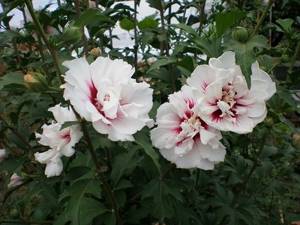
Shrubs can be propagated by cuttings both in spring and summer. To do this you need:
- cut cuttings with two or three internodes 10-15 cm long, remove all the lower leaves and half of the upper ones.
- treat cuttings with growth stimulants.
- then plant them in greenhouses with a substrate consisting of peat, humus and sand, water well, cover with film and heat from below. You can also try rooting the cuttings in a jar of water, keeping them there until roots appear and protecting them from direct sunlight. When the cuttings become stronger, they can be planted directly in flowerpots with prepared soil.
- if everything is done correctly, within a month the hibiscus cuttings will take root, after which they need to be transplanted from the greenhouses into pots with a specially prepared substrate, consisting of leaf and turf soil, peat and sand, taken in equal parts.
- a newly planted flower needs to be watered regularly, and when new shoots grow, they are pinched to stimulate tillering. As soon as the bush is formed, it can be transplanted into open ground to a permanent place, and with proper care it will bloom in the first year after planting.
If you had to cut hibiscus in cold weather, for the winter the greenhouses with shoots need to be well insulated with dry foliage or any other covering material.
Diseases and pests
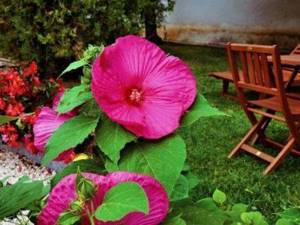
The reason for the intensive falling of leaves may be hidden in the rotting of the root system. This is caused by excessive watering or infection of the plant by pests such as wireworms and cockchafers. If spots have formed on the surface of the leaves, this may be caused by fungi or bacteria. The leaves are torn off and burned.
Diseases
The Syrian rose is rarely affected by insects or diseases, however, in drought, without watering for a long time, it can be attacked by thrips, aphids, whiteflies and spider mites. You can get rid of them by double treating the shrub with Actellik, Fitoverm, Intavir or Karbofos with an interval between treatments of 7-10 days.
The biggest danger for hibiscus is chlorosis (a disease in which the formation of chlorophyll is disrupted and photosynthesis is reduced). The manifestation of chlorosis on a Syrian rose looks like this: the lower leaves fall off, the new ones have a yellowish color. The cause of chlorosis is a lack of nitrogen and iron in the soil, therefore, when watering, iron chelate should be added, and in the spring, a complex fertilizer containing nitrogen should be added to the soil.
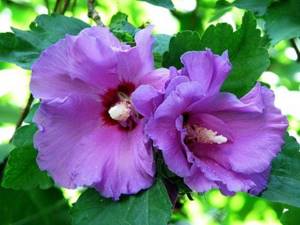
There are also the following deviations in the growth and development of the Syrian rose:
- lack of flowering with proper care. Perhaps the issue is a lack of phosphorus or boron. If shoot growth slows down, there is a lack of not only these elements, but also nitrogen. Treatment consists of timely application of the necessary fertilizers.
- yellowing of leaves. This happens: as a result of chlorosis (what to do in this case is described just above), with insufficient watering during drought (watering should be increased) or with injury to the root system, which the flower could receive during transplantation. If this is the case, it is necessary to add zircon or root when watering according to the instructions and spray the leaves with their solution at the rate of 3 drops per 0.5 liter of water.
- leaf fall. In autumn this is a natural process, but if the leaves fall earlier than expected, this is a consequence of insufficient or excessive watering or root injury.
- the appearance of spots on the leaves. This is the result of the work of harmful bacteria or fungus. Such leaves should be immediately removed and burned to prevent the infection from spreading further.
Similar flowers
There are many flowers similar to Syrian hibiscus . One of them is a North American species - bright red hibiscus. Large bloody flowers form on it in summer. This typically subtropical species has dark green leaves. Hibiscus variata is a perennial plant. This well-developed deciduous shrub plant is characterized by:
- umbrella crown;
- heart-shaped leaves;
- flowers that change color depending on the time of day.
In the morning, hbiscus flowers are light, in the evening - dark. The peculiarity of cassava hibiscus is its wide, rough leaves. The plant blooms with bright yellow flowers with a crimson core. This species belongs to medicinal and edible plants.
The perennial deciduous swamp hibiscus has oval leaves and rich scarlet buds . The plant is distinguished by its resistance to cold and unpretentiousness. Trifoliate hibiscus grows in North and Central Africa. It grows up to 80 cm. It has small flowers up to 4 cm, which bloom from morning to noon. They are colored yellow with a dark red core. Flowering lasts 1 month.
Syrian hibiscus is a perennial plant. If it is at home, it may well bloom in winter. Syrian hibiscus, with proper care, grows in one place for more than 20 years. At the same time, it does not need to be transplanted or updated.

